Sulfonylureas are another group of agent used to control blood glucose level. These drugs are only effective in patients who have functioning beta cells. They are not effective for all diabetics and may lose their effectiveness over time with others.
Sulfonylureas are further classified as first-generation or second-generation sulfonylureas.
Use of first-generation sulfonylureas is declining as more effective drugs have become available. Also, they are now thought to possibly cause an increase in cardiovascular death.
Use of second-generation sulfonylureas have several advantages over first-generation, including: safer for patients with renal dysfunction as they are excreted in urine and bile, absence of interaction to many protein-bound drugs, and longer duration of action.
All of sulfonylureas can cause hypoglycemia.
Table of Contents
- Sulfonylureas: Generic and Brand Names
- Therapeutic Action
- Indications
- Pharmacokinetics
- Contraindications and Cautions
- Adverse Effects
- Interactions
- Nursing Considerations
- Practice Test: Sulfonylureas
- Recommended Resources
- See Also
- References and Sources
Sulfonylureas: Generic and Brand Names
Here is a table of commonly encountered sulfonylureas, their generic names, and brand names:
- First-generation sulfonylureas:
- chlorpropamide (Diabinese)
- tolazamide (Tolinase)
- tolbutamide (Orinase)
- Second-generation sulfonylureas:
- glimepiride (Amaryl)
- glipizide (Glucotrol)
- glyburide (Diabeta, Micronase)
Therapeutic Action
The desired and beneficial action of sulfonylureas:
- Sulfonylureas stimulate insulin release from the beta cells in pancreas. They improve insulin binding to insulin receptors and may actually increase the number of insulin receptors.
- They are also known to increase the effect of antidiuretic hormone on renal cells.
Indications
Sulfonylureas are indicated for the following medical conditions:
- Sulfonylureas are used as adjunct to diet and exercise for the treatment of type 2 diabetes older than 10 years of age; extended release form for patients older than 17 years of age; adjunct treatment with polycystic ovary syndrome.
Pharmacokinetics
Here are the characteristic interactions of sulfonylureas and the body in terms of absorption, distribution, metabolism, and excretion:
| Route | Onset | Peak | Duration |
| Oral | Slow | 2-2.5 h | 10-16 h |
| T1/2: 6.2-17 h Metabolism: liver Excretion: urine |
Contraindications and Cautions
The following are contraindications and cautions for the use of sulfonylureas:
- Allergy to sulfonylureas. Avoid hypersensitivity reactions
- Type 1 diabetes. These patients do not have functioning beta cells and would have no benefit from the drug.
- Pregnancy and lactation. Potential adverse effect on the fetus or neonate.
Adverse Effects
Use of sulfonylureas may result to these adverse effects:
- Hypoglycemia (most common)
- GI distress (nausea, vomiting, epigastric discomfort)
- Allergic skin reactions
Interactions
The following are drug-drug interactions involved in the use of sulfonylureas:
- Decreased excretion with drugs that acidify urine
Nursing Considerations
Here are important nursing considerations when administering agents to control blood glucose level:
Nursing Assessment
These are the important things the nurse should include in conducting assessment, history taking, and examination:
- Assess for contraindications or cautions (e.g. history of allergy to the drugs, pregnancy and lactation status, severe renal or hepatic dysfunction, etc.) which are contraindications in the use of these agents.
- Perform a complete physical assessment to establish baseline status before beginning therapy and to evaluate effectiveness and any potential adverse effects during therapy.
- Assess orientation and reflexes; baseline pulse and blood pressure; adventitious breath sounds; abdominal sounds and function, to monitor effects of altered glucose levels.
- Assess body systems for changes suggesting possible complications associated with poor blood glucose control.
- Investigate nutritional intake, noting any problems with intake and adherence to prescribed diet, to help prevent adverse reactions to drug therapy.
- Assess activity level, including amount and degree of exercise, which can alter serum glucose levels and dosage needs for these drugs.
- Monitor blood glucose levels as ordered to evaluate effectiveness of drug and glycemic control.
- Monitor results of laboratory tests, including urinalysis, for evidence of glycosuria, and renal and liver function tests, to determine the need for possible dose adjustment and evaluate for signs of toxicity.
Nursing Diagnoses and Care Planning
Here are some of the nursing diagnoses that can be formulated in the use of this drug for therapy:
- Risk for unstable blood glucose related to ineffective dosing of antidiabetic agents
- Imbalanced nutrition: less than body requirements related to metabolic effects
- Disturbed sensory perception: kinesthetic, visual, auditory, and tactile related to glucose levels
Implementation with Rationale
These are vital nursing interventions done in patients who are taking sulfonylureas:
- Administer the drug as prescribed in the appropriate relationship to meals to ensure therapeutic effectiveness.
- Ensure that patient has dietary and exercise regimen and using good hygiene practices to improve the effectiveness of the insulin and decrease adverse effects of the disease.
- Monitor nutritional status to provide nutritional consultation as needed.
- Monitor response carefully; blood glucose monitoring is the most effective way to evaluate dose. Obtain blood glucose levels as ordered to monitor drug effectiveness.
- Monitor patients during times of trauma, pregnancy, or severe stress, and arrange to switch to insulin coverage as needed.
- Provide comfort measures to help patient cope with drug effects.
- Provide patient education about drug effects and warning signs to report to enhance patient knowledge and to promote compliance.
Evaluation
Here are aspects of care that should be evaluated to determine effectiveness of drug therapy:
- Monitor patient response to therapy (stabilization of blood glucose levels).
- Monitor for adverse effects (hypoglycemia and gastrointestinal distress).
- Evaluate patient understanding on drug therapy by asking patient to name the drug, its indication, and adverse effects to watch for.
- Monitor patient compliance to drug therapy.
Practice Test: Sulfonylureas
Here are some practice questions for this study guide. Please visit our nursing test bank page for more NCLEX practice questions.
1. All of the following are true about sulfonylureas, except:
A. It is indicated for all diabetic patients
B. First-generation sulfonylureas have shorter duration of action than second-generation sulfonylureas.
C. They can increase the number of insulin receptors
D. Some patients develop resistance over time
1. Answer: A. It is indicated for all diabetic patients
It is only indicated for patients with functioning beta cells. Therefore, not all diabetic patients are candidate for this drug. Patients with type 1 diabetes do not have functioning beta cells and would have no benefit from the drug.
2. Nurse Janine is taking care of a diabetic patient for the first time. The patient is on sulfonylureas and was asking about its role in managing diabetes. Which of the following is the correct response?
A. Antidiabetic drugs is the backbone of antidiabetic therapy.
B. It can help cure diabetes together with proper diet and exercise.
C. Antidiabetic drugs are adjuncts to help control blood glucose levels.
D. They work by slowing release of insulin by beta cells, decreasing insulin receptor site sensitivity, and allowing liver release of glucose.
2. Answer: C. Antidiabetic drugs are adjuncts to help control blood glucose levels.
Proper diet and exercise are the backbone of antidiabetic therapy; antidiabetic drugs are adjuncts to help control blood glucose levels.
3. Which of the following is the most common adverse effect of taking sulfonylureas?
A. GI distress
B. Hypoglycemia
C. Skin reactions
D. Heartburn
3. Answer: B. Hypoglycemia
Hypoglycemia is the most common adverse effect of taking sulfonylureas. Other common adverse effects include skin reactions and GI distress.
4. The patient taking glipizide is about to be discharged. Which of the following patient statements indicate that there is a need for additional health teaching?
A. “I can take drugs and skip meals so I can lose excess sugar fast.”
B. “I still need to have exercise because this drug I’m taking is not the ultimate remedy to my health problem.”
C. “I’ll have my private duty nurse take my blood glucose level as instructed by the doctor.”
D. Both A and B
4. Answer: A. “I can take drugs and skip meals so I can lose excess sugar fast.”
It is important for nurses to investigate nutritional intake, noting any problems with intake and adherence to prescribed diet, to help prevent adverse reactions to drug therapy.
5. Which of the following is a first-generation sulfonylureas?
A. Metformin
B. Tolbutamide
C. Glimepiride
D. Pioglitazone
5. Answer: B. Tolbutamide
The first-generation sulfonylureas include chlorpropamide, tolbutamide, and tolazamide. Glimepiride is a second-generation sulfonylurea. Metformin is a biguanide. Pioglitazone is a thiazolidinedione.
Recommended Resources
Our recommended nursing pharmacology resources and books:
Disclosure: Included below are affiliate links from Amazon at no additional cost from you. We may earn a small commission from your purchase which will help support us. Thank you! For more information, check out our privacy policy.
Pharm Phlash! Pharmacology Flash Cards #1 BEST SELLER!
Test-yourself review cards put critical clinical information for nearly 400 of the top generic medications at your fingertips. And, you can count on them for accuracy, because each card is based on content from Davis’s Drug Guide for Nurses. Increase your test scores in pharmacology class.
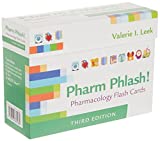
Focus on Pharmacology (8th Edition)
Focus on Nursing Pharmacology makes challenging concepts more approachable. Engaging learning features cultivate your clinical application, critical thinking and patient education capabilities. This updated 8th edition builds on your knowledge of physiology, chemistry and nursing fundamentals to help you conceptualize need-to-know information about each group of drugs.
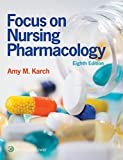
Pharmacology Made Incredibly Easy (Incredibly Easy! Series®)
Nursing pharmacology guide offers step-by-step guidance so you can grasp the fundamentals in enjoyable Incredibly Easy style. This is the perfect supplement to class materials, offering solid preparation for NCLEX® as well as a handy refresher for experienced nurses. Colorfully illustrated chapters offer clear, concise descriptions of crucial nursing pharmacology concepts and procedures.
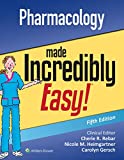
Lehne’s Pharmacology for Nursing Care (11th Edition)
The Eleventh Edition of Lehne’s Pharmacology for Nursing Care provides a thorough understanding of key drugs and their implications for nursing care. This text, written by renowned nursing educators, helps you comprehend and apply pharmacology principles. A clear and engaging writing style simplifies complex concepts, making even the most challenging pharmacology content enjoyable. We recommend this book if you want a comprehensive nursing pharmacology guide.
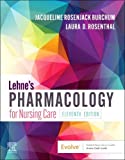
Nursing Drug Handbook
Nursing2023 Drug Handbook delivers evidence-based, nursing-focused drug monographs for nearly 3700 generic, brand-name, and combination drugs. With a tabbed, alphabetical organization and a “New Drugs” section, NDH2023 makes it easy to check drug facts on the spot.
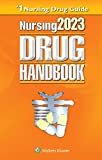
Pharmacology and the Nursing Process
The 10th edition of Pharmacology and the Nursing Process offers practical, user-friendly pharmacology information. The photo atlas contains over 100 unique illustrations and photographs depicting drug administration techniques. Updated drug content reflects the most recent FDA drug approvals, withdrawals, and therapeutic uses.
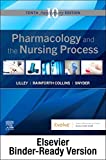
Mosby’s Pharmacology Memory NoteCards: Visual, Mnemonic, and Memory Aids for Nurses
The 6th edition of Mosby’s Pharmacology Memory NoteCards: Visual, Mnemonic, & Memory Aids for Nurses incorporates illustrations and humor to make studying easier and more enjoyable. This unique pharmacology review can be utilized as a spiral-bound notebook or as individual flashcards, making it ideal for mobile study.
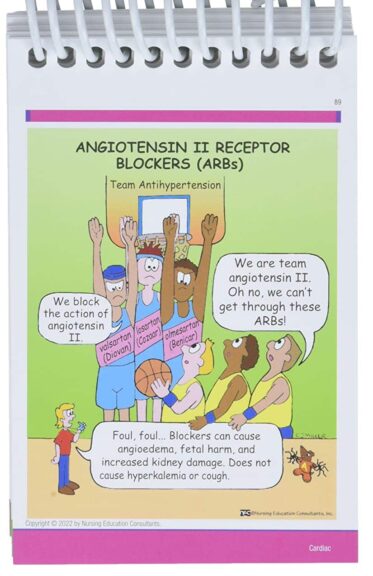
See Also
Here are other nursing pharmacology study guides:
- Nursing Pharmacology – Study Guide for Nurses
Our collection of topics related to nursing pharmacology - Pharmacology Nursing Mnemonics & Tips
These nursing mnemonics aim to simplify the concepts of pharmacology through the use of a simple, concise guide. - Generic Drug Name Stems Cheat Sheet
Learn about these generic drug name stems to help you make sense of drugs easier! - Common Drugs and Their Antidotes
A guide to drug antidotes that nurses should be familiar about. - IV Fluids and Solutions Guide & Cheat Sheet
Get to know the different types of intravenous solutions or IV fluids in this guide and cheat sheet. - Drug Dosage Calculations NCLEX Practice Questions (100+ Items)
Care to take the challenge? This quiz aims to help students and registered nurses alike grasp and master the concepts of medication calculation.
Drug Guides NEW!
Individual drug guides and nursing considerations for the most common medications used in nursing pharmacology:
- Acetaminophen (Tylenol)
- Aspirin
- Atorvastatin (Lipitor)
- Enoxaparin (Lovenox)
- Furosemide (Lasix)
- Gabapentin
- Hydromorphone (Dilaudid)
- Lisinopril
- Metoprolol
- Morphine
Gastrointestinal System Drugs
Respiratory System Drugs
- Antihistamines
- Bronchodilators and Antiasthmatics
- Decongestants
- Expectorants and Mucolytics
- Inhaled Steroids
- Lung Surfactants
Endocrine System Drugs
- Adrenocortical Agents
- Antidiabetic Agents
- Glucose-Elevating Agents
- Hypothalamic Agents
- Insulin
- Parathyroid Agents: Bisphosphonates, Calcitonins
- Pituitary Drugs
- Sulfonylureas
- Thyroid Agents
Autonomic Nervous System Drugs
- Adrenergic Agonists (Sympathomimetics)
- Adrenergic Antagonists (Sympatholytics)
- Anticholinergics (Parasympatholytics)
- Cholinergic Agonists (Parasympathomimetics)
Immune System Drugs
Chemotherapeutic Agents
- Anthelmintics
- Anti-Infective Drugs
- Antibiotics
- Antifungals
- Antineoplastic Agents
- Antiprotozoal Drugs
- Antiviral Drugs
Reproductive System Drugs
Nervous System Drugs
- Antidepressants
- Antiparkinsonism Drugs
- Antiseizure Drugs
- Anxiolytics and Hypnotic Drugs
- General and Local Anesthetics
- Muscle Relaxants
- Narcotics, Narcotic Agonists, and Antimigraine Agents
- Neuromuscular Junction Blocking Agents
- Psychotherapeutic Drugs
Cardiovascular System Drugs
References and Sources
References and sources for this pharmacology guide for Sulfonylureas:
- Karch, A. M., & Karch. (2011). Focus on nursing pharmacology. Wolters Kluwer Health/Lippincott Williams & Wilkins. [Link]
- Katzung, B. G. (2017). Basic and clinical pharmacology. McGraw-Hill Education.
- Lehne, R. A., Moore, L. A., Crosby, L. J., & Hamilton, D. B. (2004). Pharmacology for nursing care.
- Smeltzer, S. C., & Bare, B. G. (1992). Brunner & Suddarth’s textbook of medical-surgical nursing. Philadelphia: JB Lippincott.
